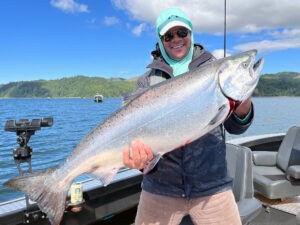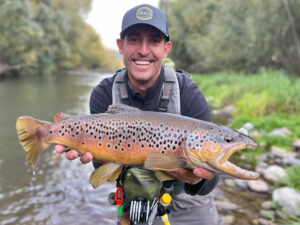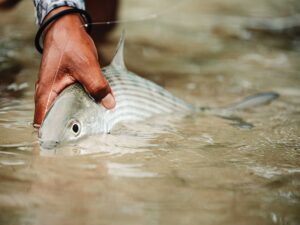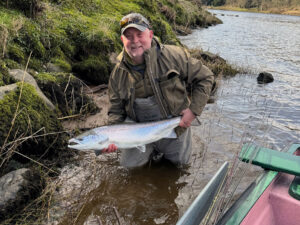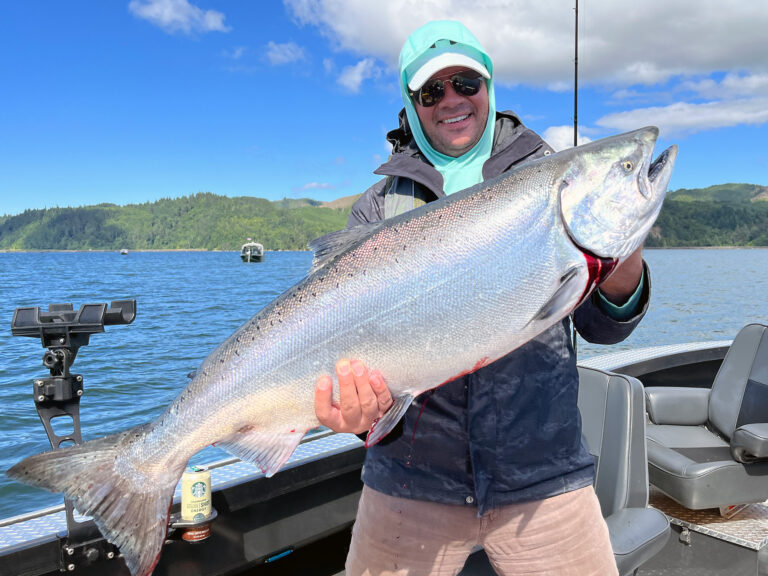A large swath of the northern section of Baja California Sur’s Pacific coast (aka Pacifico Norte) is a forgotten place for most anglers, who get never get closer than Cabo or — via long-range sport-fishers — seamounts far offshore. This gallery is dedicated to sharing this special place with anglers who want to fish far from the madding crowds. It’s adapted from the feature in the July/August issue of Sport Fishing.
A Forgotten Place
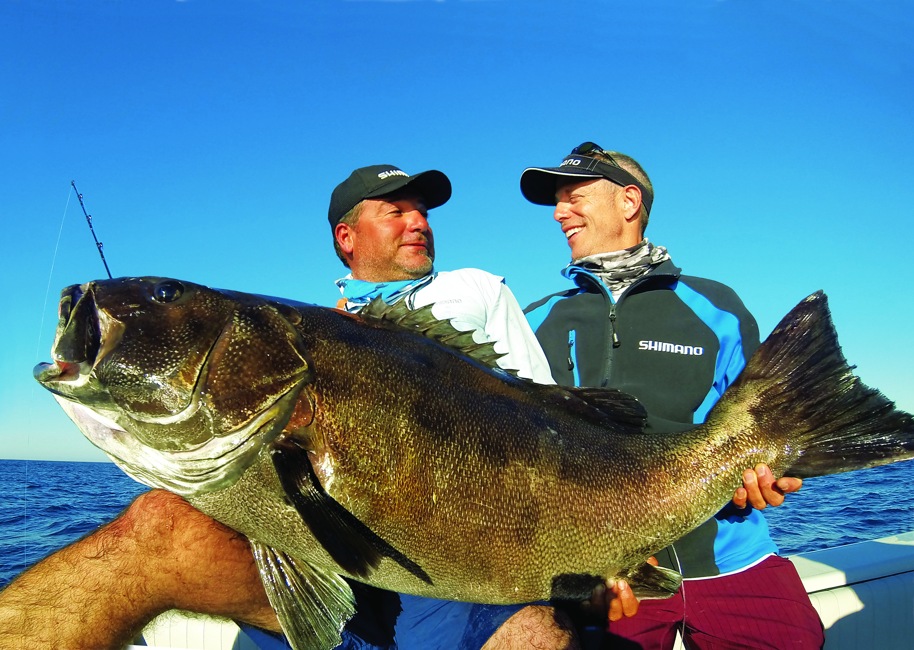
A Forgotten Place
You have to really want to get to this “lost coast”; unless you have your own plane, there is no quick-and-easy, casual means to reach these desert shores. Those who do make the trek, whether by small plane, boat or vehicle, will be rewarded with a unique experience in a remote area unspoiled by willy-nilly development. And as you might guess, they’ll find some fabulous fishing.
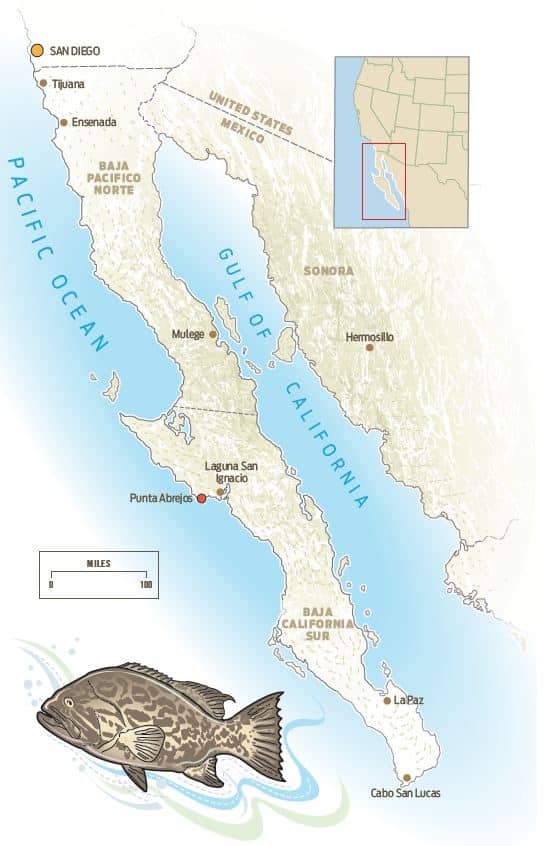
Grouper Heaven
In fall 2012, I joined a group of anglers from the United States to explore this coast with Julio Meza, who has probably sport-fished these waters more than anyone. These days he does it from Spanish Fly, the 39-foot 390 SeaVee he purchased after his friend, the legendary Jose Wejebe, died in a plane crash in 2012. We targeted a variety of game fish but particularly grouper. Meza is the king of groupers: He loves to fish for them (releasing most), and on this trip proved his prowess, consistently outfishing some excellent anglers.The group also included Dave Pfeiffer and Chris Russell with Shimano; Jim Hendricks, Sport Fishing‘s Pacific editor; and yours truly.
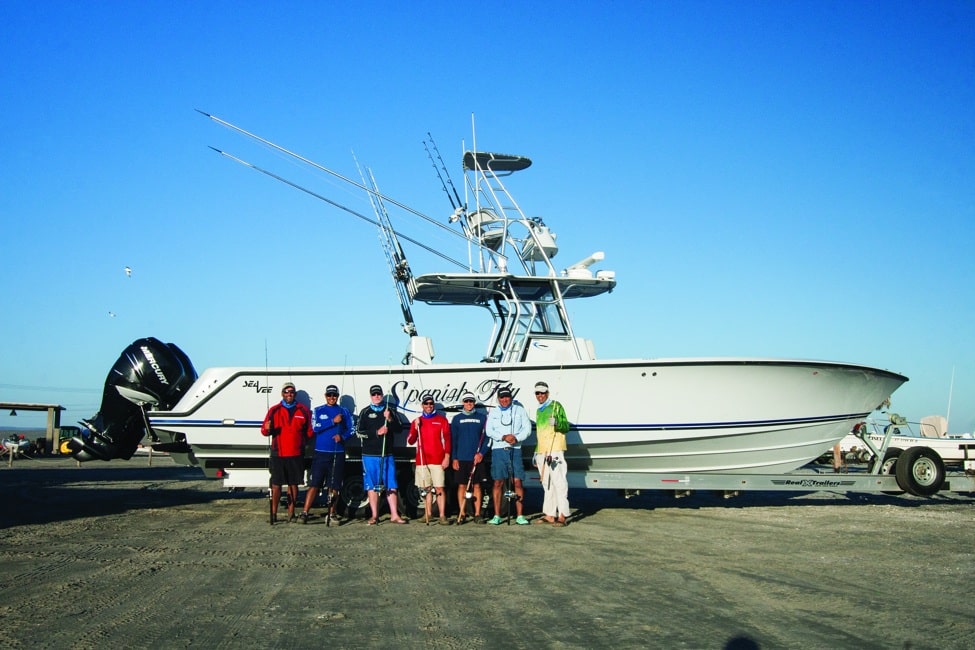
High Fishing Expectations
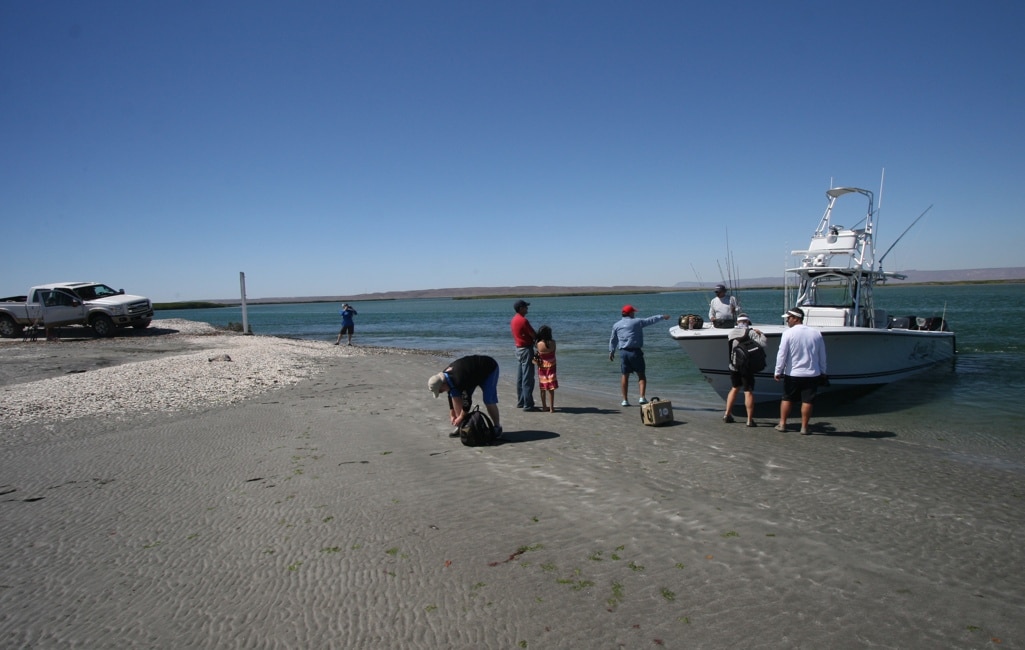
Knowing that groupers — broomtails and gulf grouper — would be a primary target, I was confused when Meza stopped us in about 30 feet of water. I had geared up with a fairly heavy Butterfly jig, ready to drop to bottom in, well, more grouperlike depths of 100 to 300 feet.
No need for such heavy jigs, as it turned out. We fished 20 to 40 feet of water that day, over lightly pressured nearshore reefs south of the estero, down toward San Ignacio Lagoon.
And in fact, on this day, I could have left my jigs at home as well. Besides the water being pretty shallow for working iron, live baits were what the grouper wanted, and what we gave ’em.
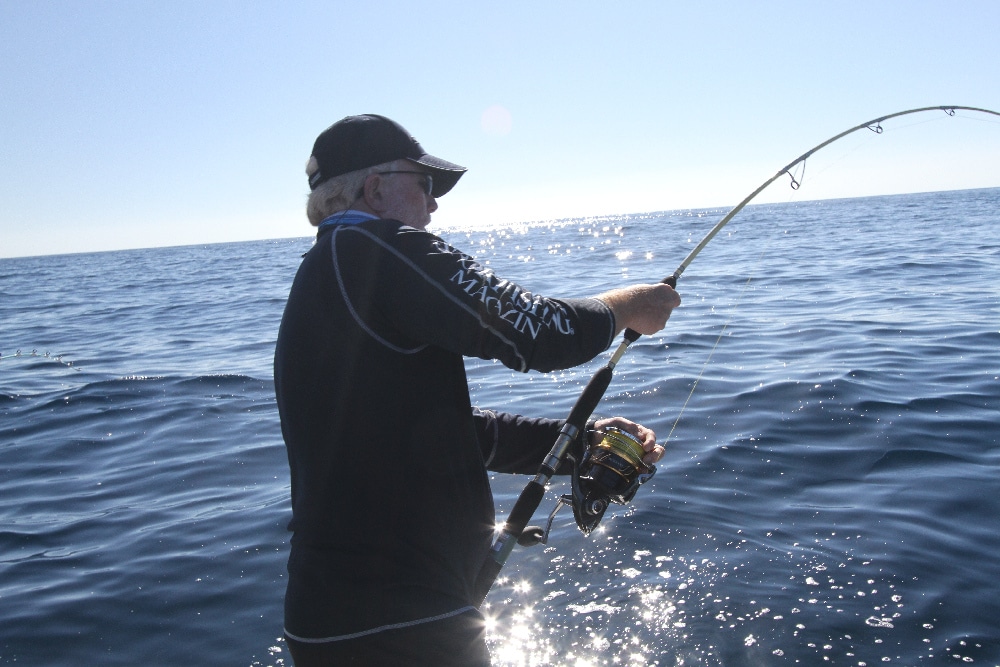
The result was a good bite on broomtails, ranging from 15 to 60 pounds. We had put a good number of small mackerel in the livewell, and that paid off. A great advantage of fishing such shallow water meant we had no problem releasing most of our grouper unharmed. (Meza is a firm believer in releasing fish not needed for immediate consumption.)
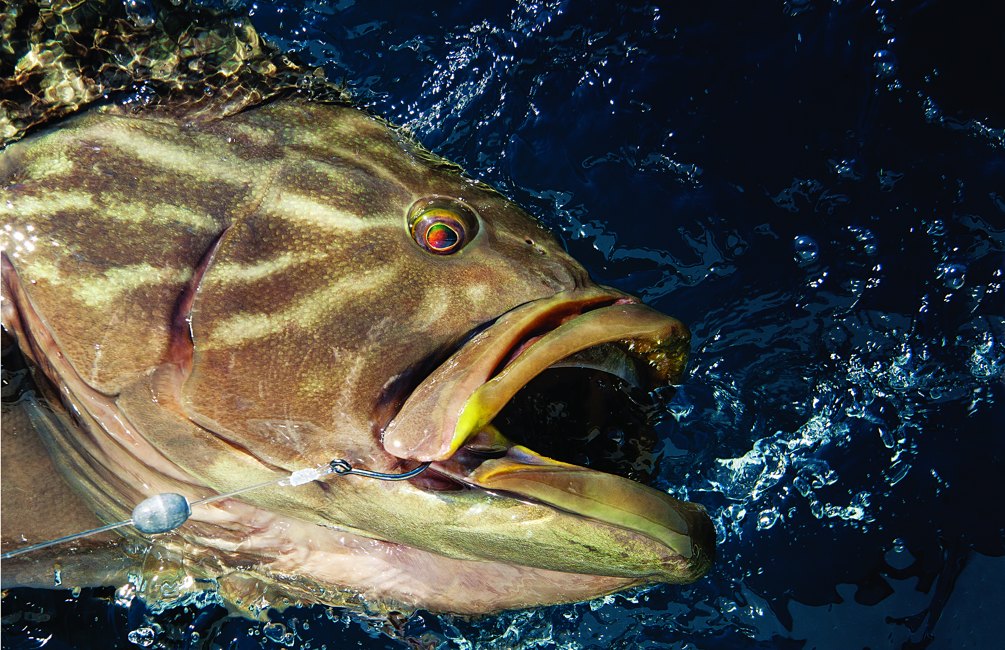
We also tried some Lucanus “slow” jigs as this one fished by Dave Pfeiffer, and these accounted for a variety of other sea basses — kelp, sand and spotted bay bass — though none exceeded a few pounds.
Overall, our first day offered action aplenty, and other, larger quarry were yet to come this trip.
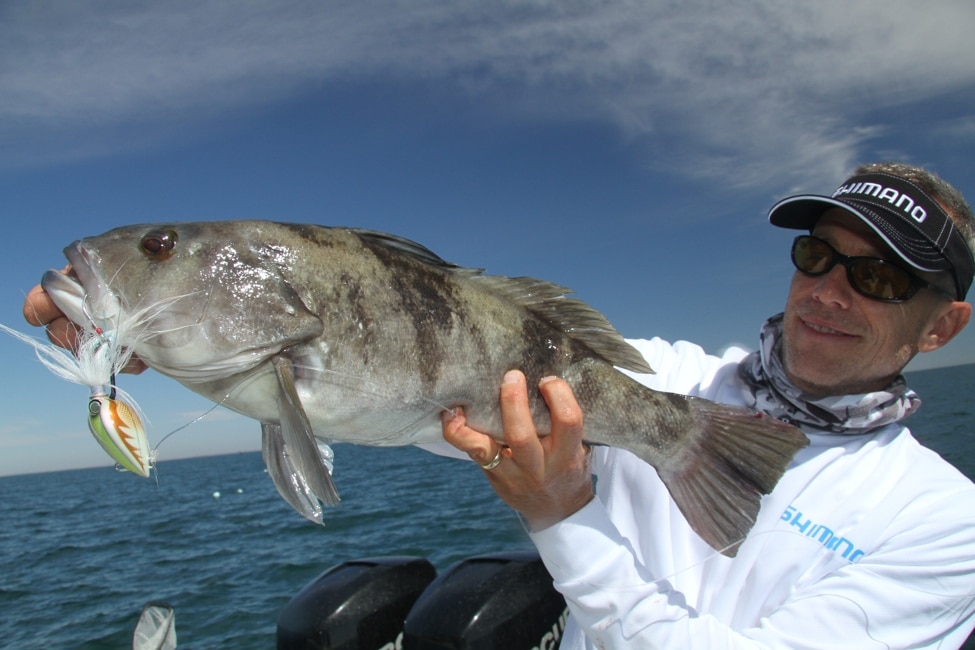
Reaching Out to Visiting Anglers
“Punta Abreojos and the La Bocana area are the best grouper-fishing spots on Earth, and I’ve fished basically all over the world,” says Julio Meza who, when not fishing, heads up major produce operations based out of San Quintin in northern Baja and runs fishco.net, a large tackle outlet located in Ensenada.
In part, of course, the healthy stocks of large benthic predators have to do with productive habitat and plenty of food along the central Baja coast. But the quality of the sport fishing here also has to do with Meza himself. As a businessman, he works closely with the cooperativas that govern all the artisanal commercial fishing along this part of the coast, and Meza has persuaded them to adopt policies that ensure good numbers of grouper, yellowtail, kelp (calico) bass and other species that recreational anglers prize.
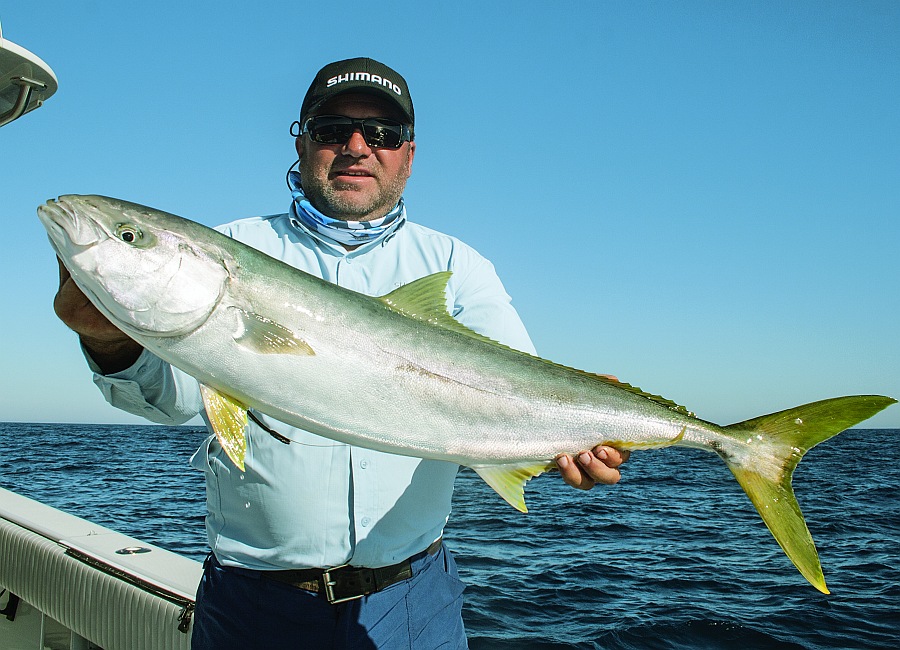
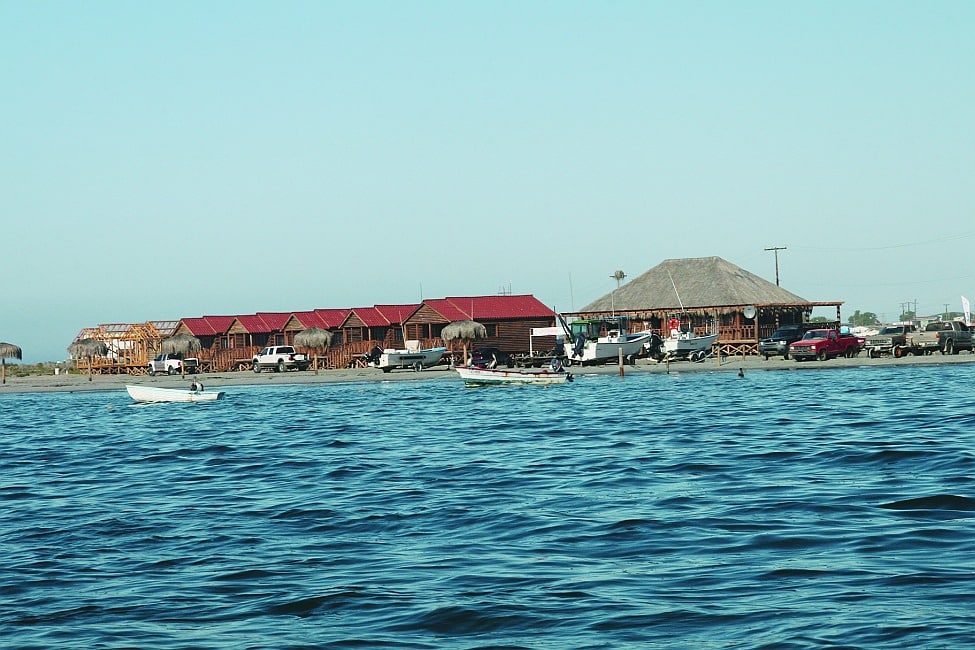
Indeed, those cooperativas are dialing into Meza’s contention that sport fisheries can be worth serious pesos to local economies and investing in super pangas set up to accommodate visiting anglers.
Unlike the situation not so many years ago, sport fishermen can now charter clean, well-kept pangas along the central coast around esteros Abreojos and La Bocana, and in bahias Asuncion and Tortuga, Meza says.
And in some spots, accommodations are springing up to host tourists. We stayed in the brand-new Bocana Adventures log cabins on the beach. Part of the local fishing cooperative, the half-dozen or so cabanas are clean and simple with two double beds and where we slept quite well — especially for a mere $50 per night. We also ate well at the adjoining restaurant/bar.
Exploring a Pristine Estuary
One day we joined local skippers in two of the pangas for charter to spend some time fishing inside La Bocana. For $250 per day, three or four anglers can fish the pristine estuary, where we once again scored most heavily on grouper, fishing a combination of live baits (topsmelt that our guide cast-netted, like that shown here) and lures. Dave Pfeiffer and Jim Hendricks found some shortfin corvina and spotted bay bass. That part of Baja marks the northernmost range of mangroves; at times, snook may be caught there also.
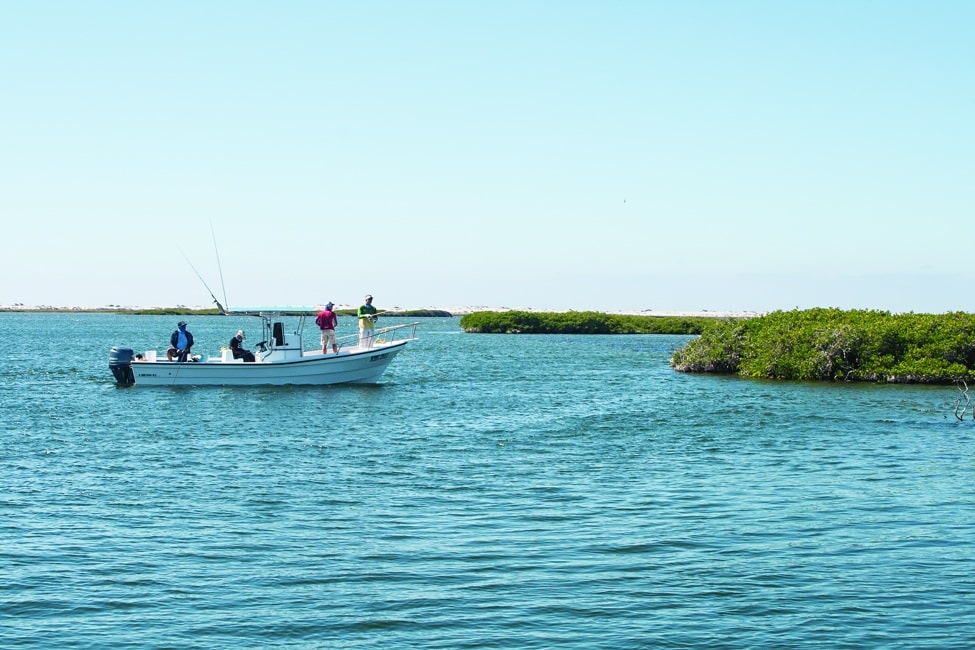
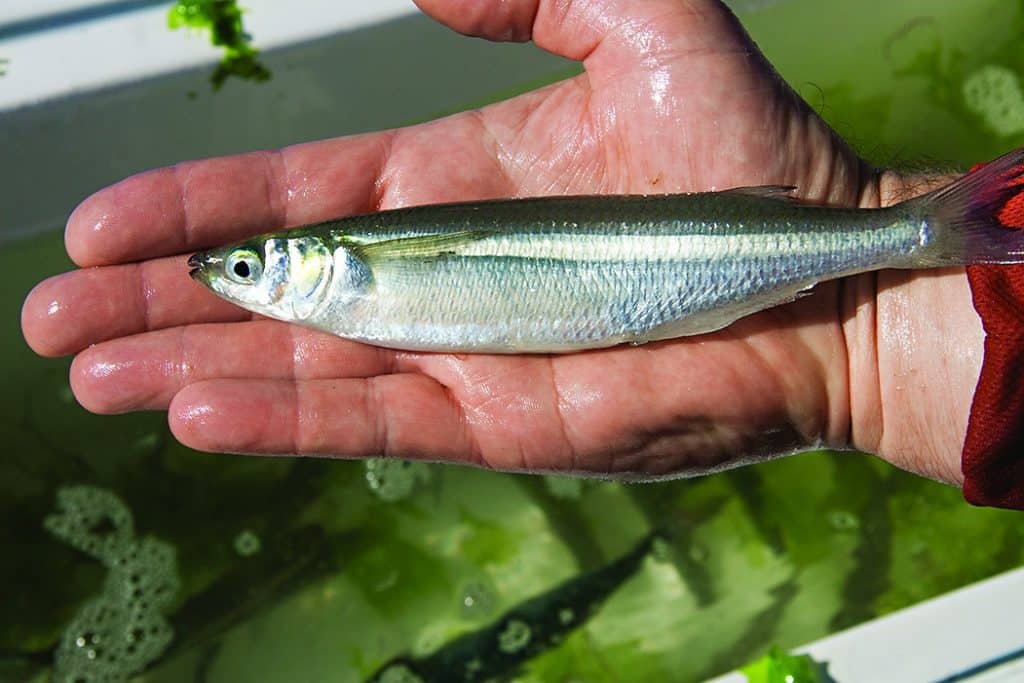
Not surprisingly, estuary grouper are smaller than those in the Pacific, they’re very aggressive and, as anyone with experience fishing grouper in shallow water knows, very fast. Dave Pfeiffer (shown here) discovered that early on. At one point, Chris Russell, with Shimano, was reeling an Orca lure back to the panga, when a broomtail of maybe 7 pounds made us all jump when it came completely out of the calm water next to the boat, trying to eat the lure. Our skipper said there are 20- to 30-pounders in the Bocana, but rarely are anglers able to stop them before they get into or behind line-shredding structure.
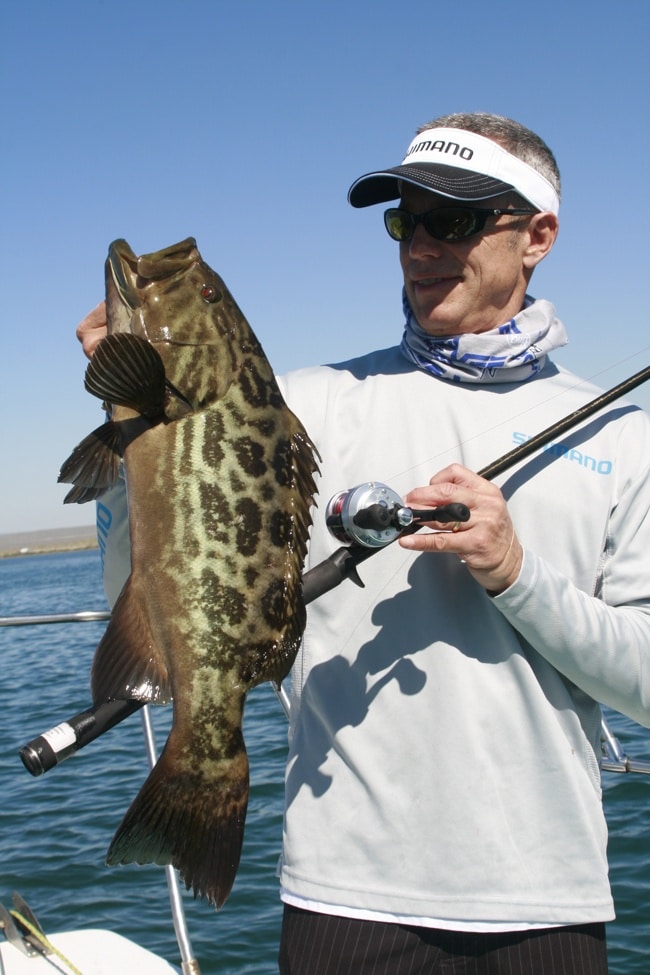
It turned out to be a great day to fish the estuary since the wind had come up the night before, and what was a pleasant breeze rippling the protected bocana was a white-capping blow on the open Pacific. That afternoon, we hopped in Meza’s truck, and he took us to a beach where, on the rising tide, we had a blast catching California halibut — like this flattie taken by Pfeiffer — on soft plastics.
This can be a windy coast, certainly, but generally not enough to keep boats in. Our days varied from very calm to moderately breezy to downright windy.
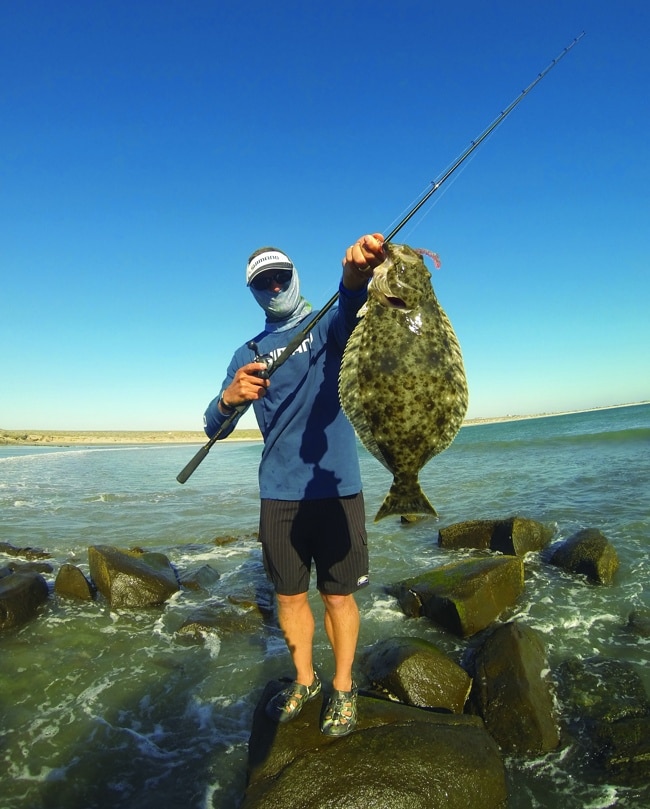
Where Giants Still Lurk
Meza had said we’d see some giant sea bass, and so we did. I didn’t actually see the one I hooked, however, but I certainly felt it. I’d been having a bit of sport for sand bass on small metal jigs in 40 feet or so, and dropped one down on a circle hook. Shortly after I’d lowered the live bait, a freight train came by: As line melted from my spool, suddenly the train was gone, leaving only my mangled bait.
Meza then did the same but with a larger circle hook and a better result: After a considerable struggle at the rail, he boated a bass estimated to weigh 75 or 80 pounds.
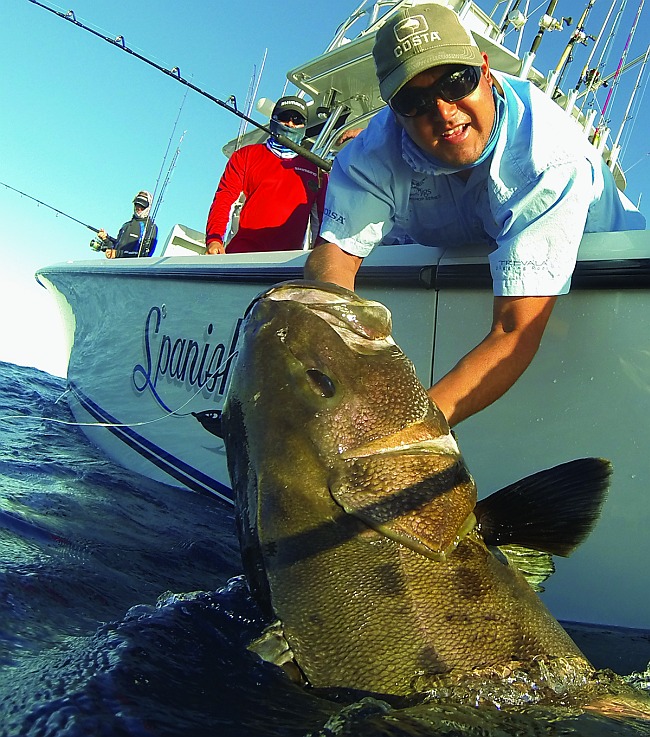
While giant sea bass (and, for that matter, the broomtail grouper) are protected in California, which is the northernmost part of its range, stocks are in good shape here; keeping them is legal. Still, Meza rarely does so, but this day, with a boatload of anglers to share it, the sea bass went into the box.
That fish impressed the hell out of me, but not Meza, who has winched up black sea bass in these waters that he figured had to be well over 200 pounds.
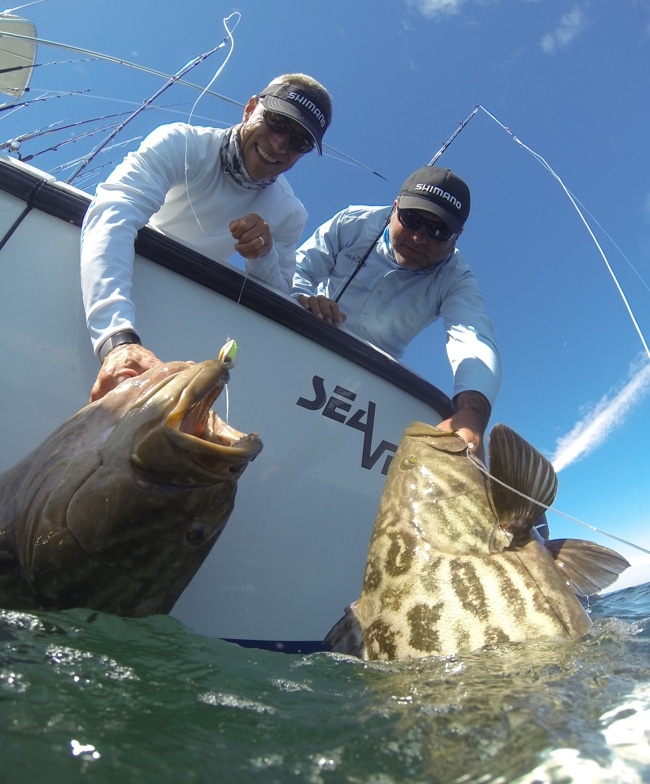
We also caught yellowtail, dorado and other species that day. Had we spent much time trolling blue water, we might have encountered good numbers of striped marlin as well as wahoo and yellowfin.
In three days of fishing, I feel I came away with only a cursory feel for all the possibilities that await anglers here. I hope to get back, and have reason to be optimistic that those angling possibilities will remain on this lost coast for a long time to come.
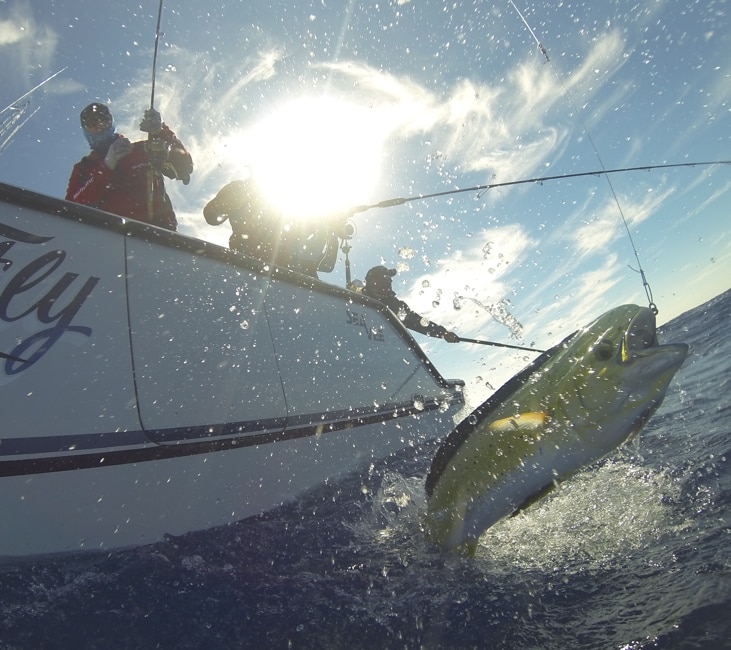
Trip Planner: Visiting Baja Pacifico Norte
Getting to this remote, generally undeveloped 150-mile stretch of Baja’s coast means boating down, flying via small plane or driving in on roads. It’s not a destination one goes to casually or without planning. But of course, the flip side is the unspoiled, uncrowded nature of this coast.
Trailer boaters can, like the commercial panga fleet, get launch on the sand (four-wheel-drive is highly recommended for your tow vehicle), and moor in the estuary at La Bocana via a slot between the breakers and sand bars. Fuel is also available at Pemex stations in town. If running south to the area, you’ll find diesel and gas at Cedros Island, where you can also find anchorage or dock space. Inside Bahia Tortugas, farther south, fuel and refuge when northwest winds blow are available.
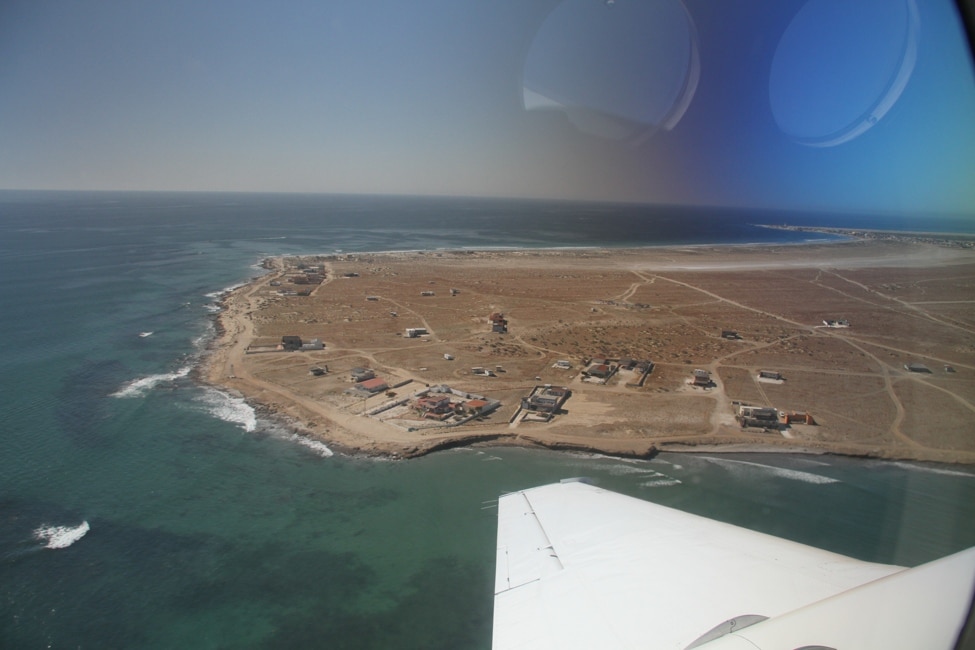
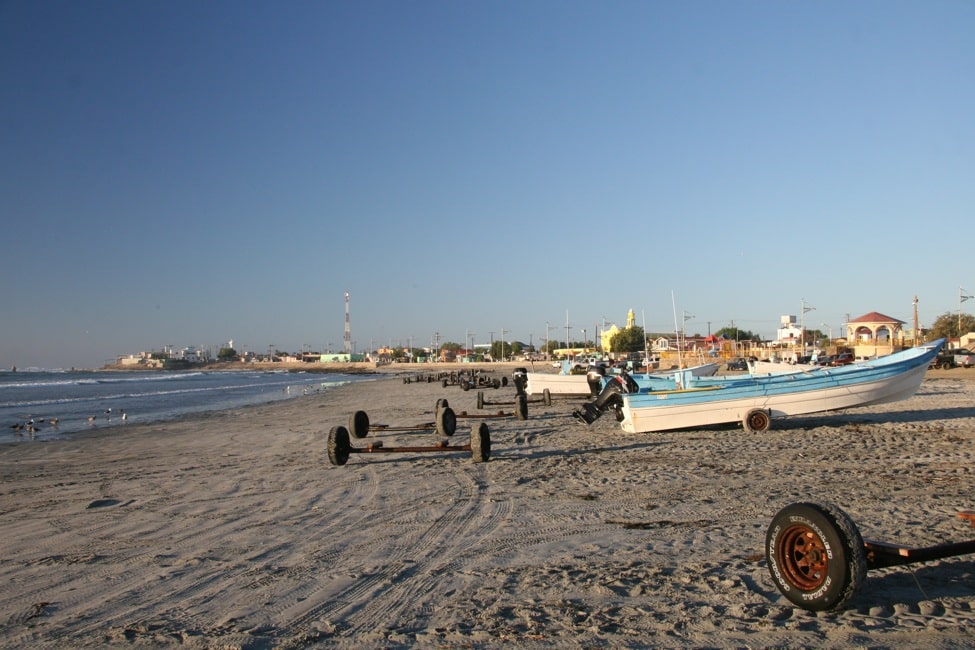
If you bring your own boat, hiring a local guide is a good idea; he can help you find fish, and this also sends a positive signal to others that you are supporting the local fishing community.
If arriving by small plane, figure about 1½ hours from Tijuana to the hard-dirt airstrip near Punta Abreojos.
If you’re driving, you’ll follow Mexico’s Transpeninsular Highway 1 from Tijuana south, through the Vizcaino turnoff south another 40 or so miles, to the turnoff that heads southwest to the Abreojos area. While the main roads should be passable for most vehicles, driving a truck or SUV — particularly with four-wheel drive — will allow for more (and more interesting) off-road options.
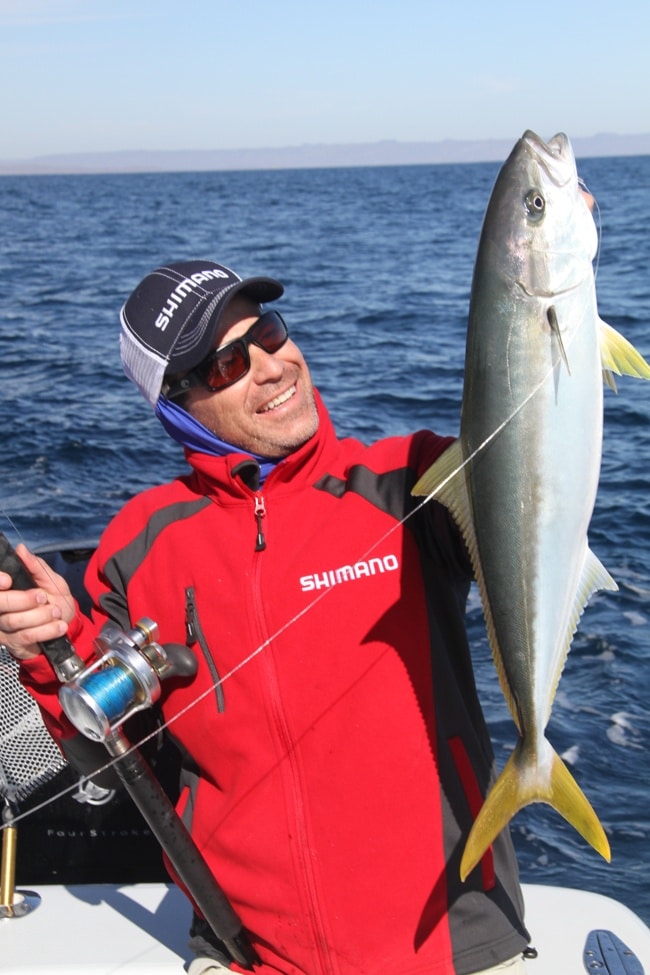
For fishing, the best time to visit is from September through December. Tourism is still in its infancy here. Accommodations options are limited and might be somewhat Spartan (i.e., don’t come looking for a five-star golf resort — at least not yet).
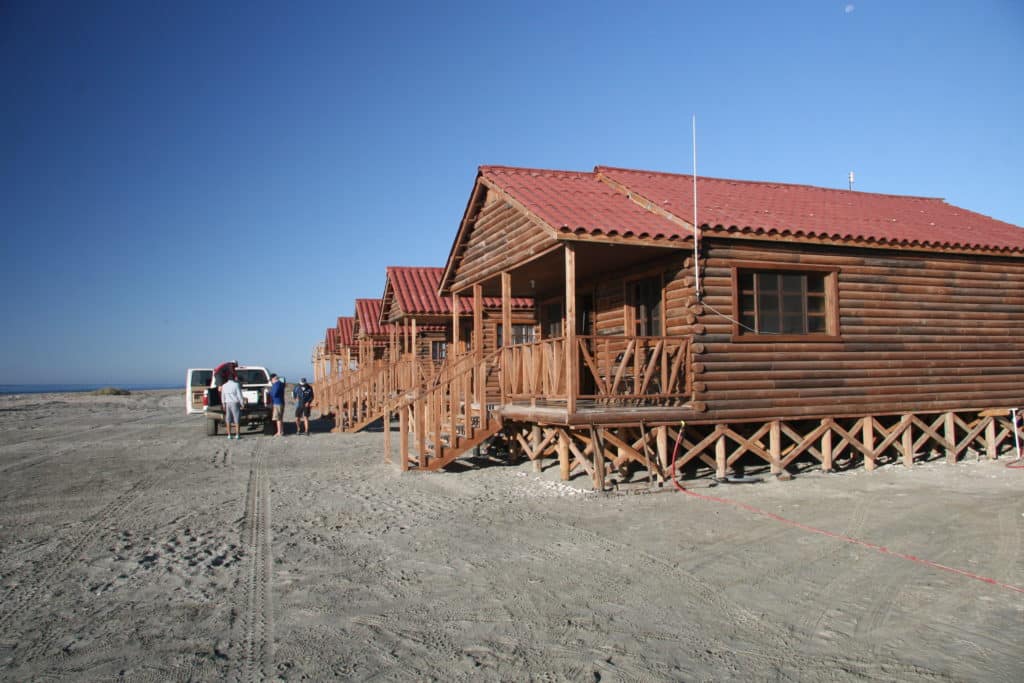
As noted, we spent several very comfortable nights at Bocana Adventures, with meals and guide service right there. And with these cabins going for $50 per night, you can’t beat the rate. Pangas can be chartered for the day rate of $250.
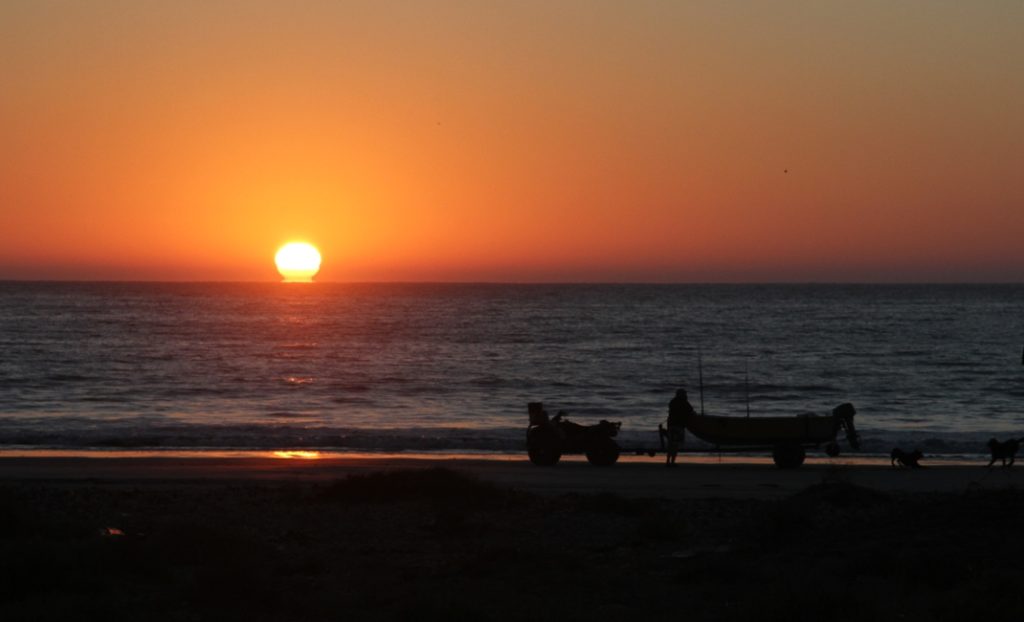
Making Contact
For more information on visiting La Bocana, email bocanaadventure_eco@hotmail.com or call captains Juanchys (01152 1 6151562060) or Joaquin (l1152 1 6151598716). You can also visit BocanaAdventure’s Facebook page.
For the Punta Abreojos area, email franky_russon@hotmail.com or call the cooperativa office at 01152 6151562060.
Alternatively, email Meza’s enterprise, fishconet@yahoo.com.mx, he says, for all arrangements to plan a trip here.
However one happens to visit here, it would be a shame to miss at least a meal or two at the Sportfishing and Cactus Bar. Owner and chef Joaquin Aguilar serves up fresh lobster, abalone, shrimp, scallops, fish and more in his cozy restaurant. (You can even email ahead: manosfriaslabocana@hotmail.com.)
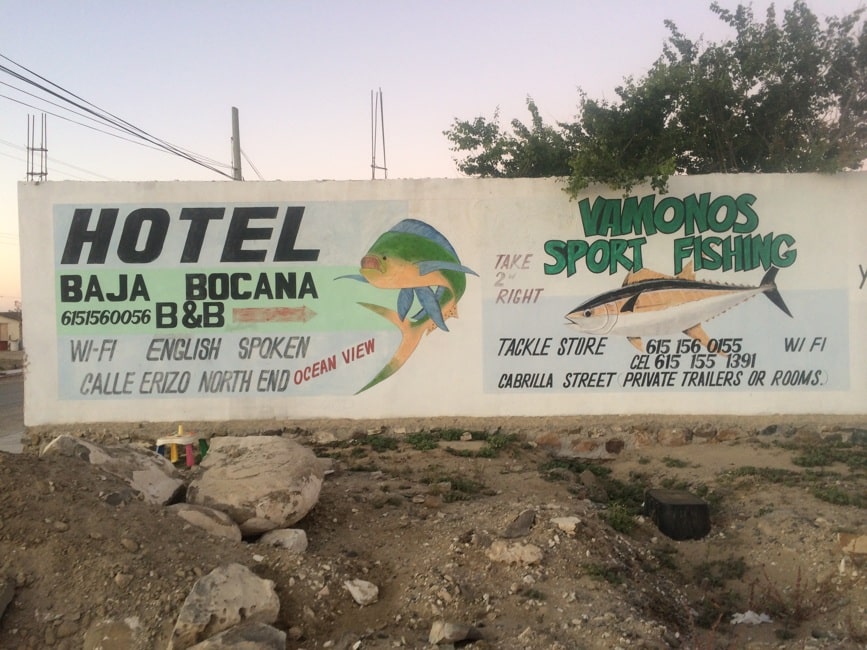
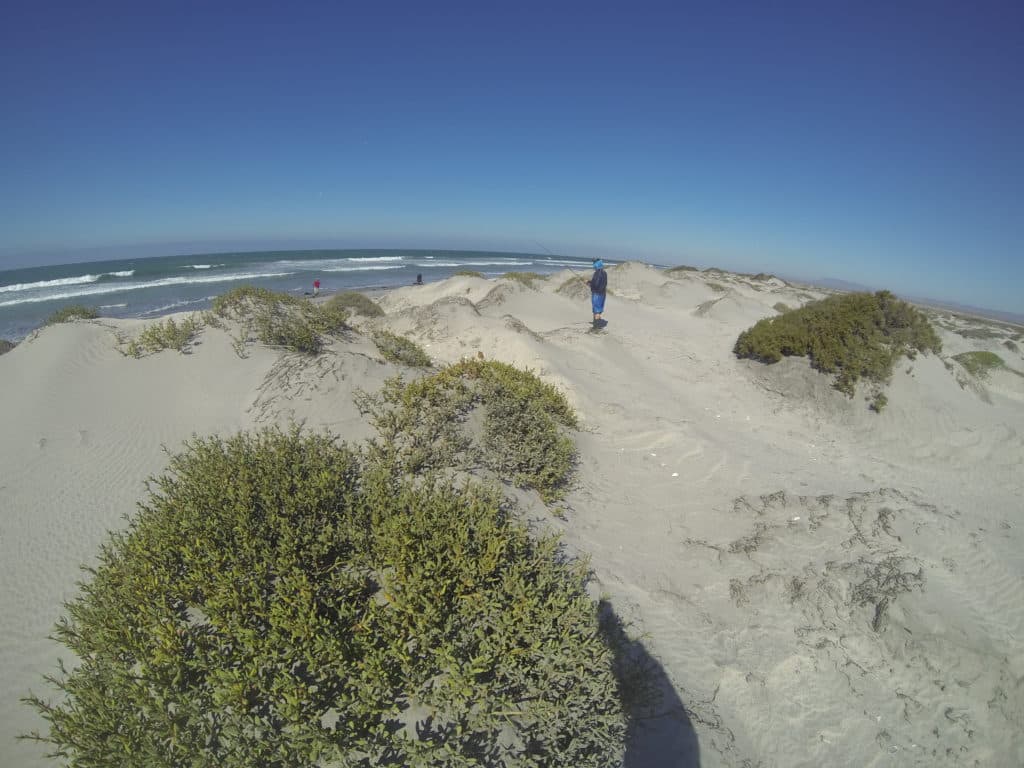
Away From it All
It’s All About the Cooperatives
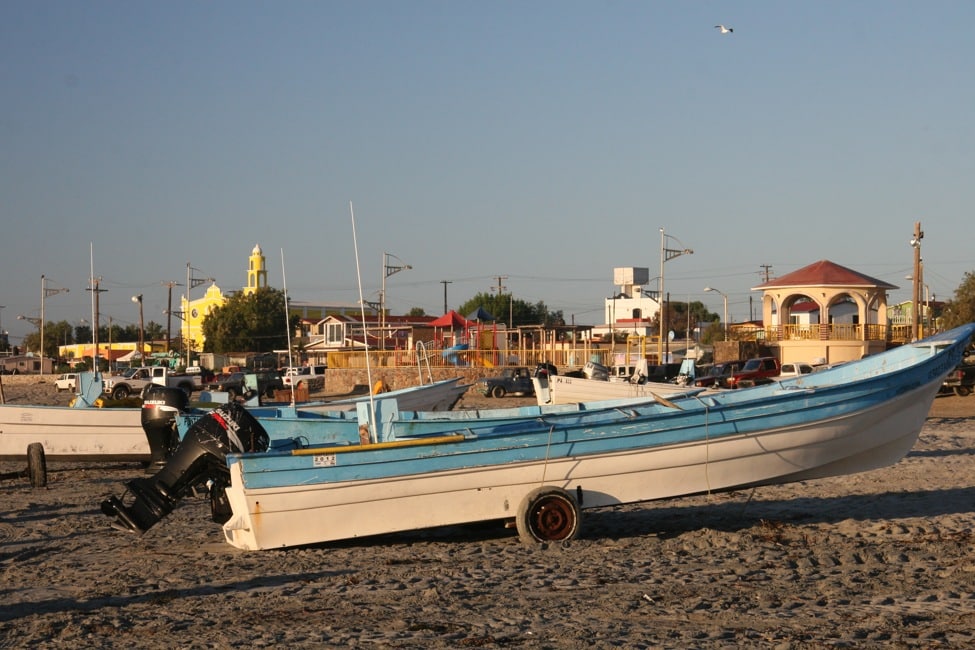
Cooperativas are one way to combat the tragedy of the commons: They dictate the harvest of fishery resources along much of Baja’s Pacific coastline. These co-ops have federal permits and long-term concessions (some dating back to the 1940s) to determine/control the harvest of lobster and other shellfish and finish.
Nine such co-ops blanket the coast from Punta Abreojos north to Cedros Island (plus another farther north on Guadalupe Island). Far more than simply fishing, the cooperativas also run processing plants to clean and freeze or cook and can much of the seafood harvested, which is shipped via boat or air.
They also watch closely over their stretches of coast. I noted what looked a lot like lifeguard huts on beaches which, Julio Meza explains, are manned by lookouts. Poachers are not tolerated.
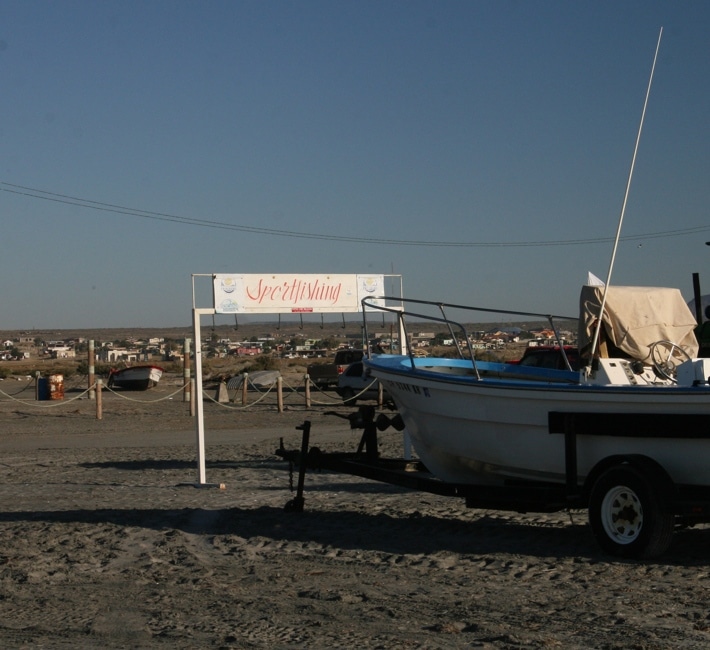
The influence of cooperativas, at least progressive-minded ones such as at Punta Abreojos (which works closely with Meza), helps ensure public support for a policy like the one that precludes commercial harvesting of grouper in favor of a bountiful sport fishery for them (while encouraging release by anglers). That influence also accounts for new tourist operations such as Bocana Adventure, which is the result of cooperativa investment, as are the new 24-foot pangas outfitted for sport fishing (no more dirty lobster boats for hire).

